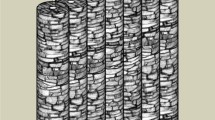Abstract
In the Japanese concept for the disposal of the high-level radioactive wastes (HLW), the potential pathways for radioactive contaminant transport would be sealed by a combination of tunnel plug, backfilling and grouting. The candidate material for these engineered barriers would be bentonite or a bentonite-based mixture taking into consideration long-term stability of the seals. Two tests of bentonite grouting for sealing an excavation damage zone (EDZ), that exists in the rock in the immediate vicinity of the tunnel, were conducted in the granitic rock at Atomic Energy of Canada Limited’s (AECL’s) Underground Research Laboratory (URL). One test was the trial for the development of grouting procedure and the evaluation of grouting effectiveness, and the second test was a demonstration of the grouting around the clay-block bulkhead of the Tunnel Sealing Experiment (TSX). In the trial, the injection proportion of 4.0% of grout slurry was the most efficient. The result of the seepage test showed that grouting resulted in a reduction of hydraulic conductivity of the EDZ in the floor of the tunnel. In the demonstration, although the hydraulic pulse test didn’t indicate that the grouting significantly reduced the rock hydraulic conductivity, the test was a useful site-scale demonstration of bentonite grout injection for the purpose of EDZ sealing around a tunnel bulkhead.
Similar content being viewed by others
References
Japan Nuclear Cycle Development Institute, H12 Project to Establish Technical Basis for HLW Disposal in Japan - Project Overview Report 2 -, the Draft Second Progress Report on Research and Development for the Geological Disposal of HLW in Japan, JNC TN1400 99-010, 1999.
N. Chandler, D. Dixon, M. Gray, K. Hara, A. Cournut and J. Tillerson, An in situ Demonstration of Technologies for Vault Sealing, Proc. 19th Annual Conference of Canadian Nuclear Society, 1998.
N. Chandler, E. Kozak and C. Martin, Connected Pathways in the EDZ and the potentialfor flow along tunnels, Proc. EDZ Workshop, Int. Conf. Deep Geological Disposal of Radioactive Waste, Canadian Nuclear Society, 1996, p. 25–34.
H. J. Ramey, R. G. Agarwal and I. Martin, Analysis of ëSlug Testí or DTS Flow Period Data, J. Can. Petroleum Technology, vol. 14, 1975, p. 37–47.
Y. Sugita and T. Fujita, Clay Grouting Experiment at the Kamaishi Mine, Proc. 27th Symposium on Rock Mechanics, 1996, p. 276–280. (in Japanese)
K. Masumoto, Y. Sugita, T. Fujita and N. Chandler, Trial of Bentonite Grouting into the EDZ at AECL’s Underground Research Laboratory, Proc. 29th Symposium on Rock Mechanics, 1999, p. 36–42.
Author information
Authors and Affiliations
Corresponding author
Rights and permissions
About this article
Cite this article
Sugita, Y., Fujita, T., Masumoto, K. et al. Clay-Based Grouting Into the EDZ for the Vault Sealing. MRS Online Proceedings Library 608, 331 (1999). https://doi.org/10.1557/PROC-608-331
Published:
DOI: https://doi.org/10.1557/PROC-608-331




